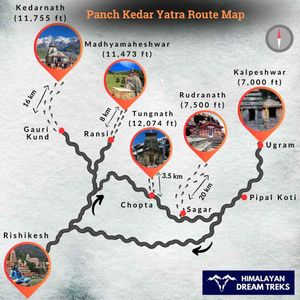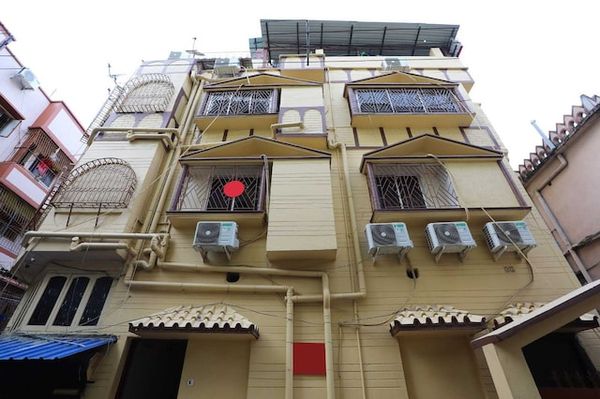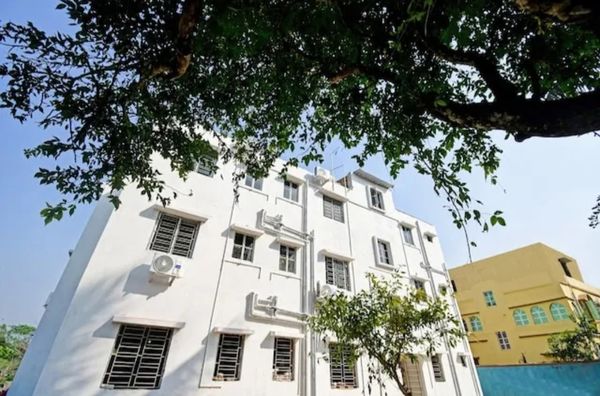The Magical Journey Through Panch Kedar: A Sacred Himalayan Trek
 Mountains Curve
20 Dec, 2024
7 mins read
2805
Mountains Curve
20 Dec, 2024
7 mins read
2805

Uttarakhand, famously known as “Devbhoomi” or the Land of Gods, has long been a sanctuary for spiritual seekers and divine energies. Among its countless revered shrines, the Panch Kedar temples hold a significant place in Hindu mythology and worship. These five sacred temples dedicated to Lord Shiva—Kedarnath, Tungnath, Madhmaheshwar, Rudranath, and Kalpeshwar—are located in the Kedarkhand region of the Garhwal Himalayas.
The Panch Kedar Yatra is not merely a pilgrimage; it is a transformative trek through unspoiled landscapes, rustic hamlets, and challenging trails. This guide provides a detailed overview of the Panch Kedar route, best visiting months, and essential tips for your trek.
A Brief Overview of the Panch Kedar Temples
Kedarnath Temple
Part of the Chota Char Dham circuit and one of the twelve Jyotirlingas, Kedarnath is the most prominent shrine in the Panch Kedar group. Situated at 3,583 meters, it stands majestically against the Kedarnath mountain range. The trek to Kedarnath begins at Gaurikund, covering a distance of 16 km.
Tungnath Temple
Famed as the world's highest Shiva temple, Tungnath is located at an altitude of 3,680 meters. The trail begins from Chopta, a picturesque location often dubbed as the “Mini Switzerland of Uttarakhand.” Trekkers often continue to Chandrashila summit for stunning views of Himalayan peaks.
Madhmaheshwar Temple
Nestled in the village of Mansoona, Madhmaheshwar lies at 3,497 meters. The trek to this serene temple starts from Ukhimath, passing through remote villages and green meadows. Its peaceful atmosphere and lush surroundings attract spiritual seekers and nature enthusiasts alike.
Rudranath Temple
Known for its challenging route, Rudranath is situated at 3,600 meters amidst dense forests and alpine meadows. Offering breathtaking views of peaks like Nanda Devi and Trishul, the trek starts from Sagar village and spans approximately 22 km.
Kalpeshwar Temple
The final stop of the Panch Kedar pilgrimage, Kalpeshwar is accessible throughout the year due to its relatively low altitude of 2,200 meters. A short trek from Urgam village leads to the temple, which is famed for the “Jata” (locks) of Lord Shiva.
Suggested Panch Kedar Route Itinerary
The journey typically unfolds as follows:
- Rishikesh → Gaurikund: Starting point of the Yatra.
- Gaurikund → Kedarnath Temple: A 16 km trek to the shrine.
- Gaurikund → Ukhimath via Guptkashi: Drive to the base for Madhmaheshwar.
- Ukhimath → Madhmaheshwar Temple: Trek through picturesque villages.
- Ukhimath → Chopta: Drive to the base for Tungnath.
- Chopta → Tungnath Temple: A 3.5 km trek to the temple.
- Sagar → Panar Bugyal → Rudranath Temple: A scenic and challenging 22 km trek.
- Sagar → Kalpeshwar Temple via Urgam: The final leg of the journey.
- Pipalkoti → Rishikesh: Concludes the pilgrimage.
Covering roughly 95 km on foot, this spiritual trek takes around 10–11 days. Below is the Panch Kedar Map-
Best Time to Embark on the Panch Kedar Trek
The ideal time to undertake this pilgrimage is between May and June or September and October. Avoid the monsoon season (July-August) due to landslide risks and slippery trails. The temples usually close for winter by late November, with reopening dates for 2024 based on the Hindu calendar. If Rudranath is your primary destination, September and October offer pleasant weather and favorable trekking conditions.
Highlights of the Trek
- Scenic Kalpeshwar to Rudranath Trail: Traverse dense forests, waterfalls, and panoramic vistas.
- Tungnath to Rudranath Trek: Encounter lush meadows and high-altitude ridges.
- Photography: Capture the enchanting landscapes, ancient temples, and snowy peaks.
Trek Costs and Packages
The trek’s cost varies depending on transportation, accommodations, and guide services. Approximate costs include:
- Guided Panch Kedar Yatra: ₹25,000–₹35,000.
- Trekking Packages: Adventure-specific packages range from ₹30,000–₹45,000, inclusive of permits and gear.
- Helicopter Services: Available for a luxurious and time-efficient journey, costing ₹60,000 or more.
Preparation Tips
- Physical Fitness: Ensure stamina and strength through regular exercise before the trek.
- Packing Essentials: Bring trekking shoes, warm clothing, rain gear, a first-aid kit, and a sturdy backpack.
- Local Guides: Hiring a guide ensures safety and a culturally enriched experience.
- Permits: Obtain necessary trekking and camping permits in advance.
Conclusion
The Panch Kedar Yatra is an extraordinary blend of spirituality and adventure, offering pilgrims and trekkers an unmatched connection to nature and divinity. With proper planning, the journey through these sacred Himalayan temples in the Garhwal Himalayas will be an unforgettable and life-enriching experience.
Written By:
Mountains Curve



Hotels at your convenience
Now choose your stay according to your preference. From finding a place for your dream destination or a mere weekend getaway to business accommodations or brief stay, we have got you covered. Explore hotels as per your mood.





